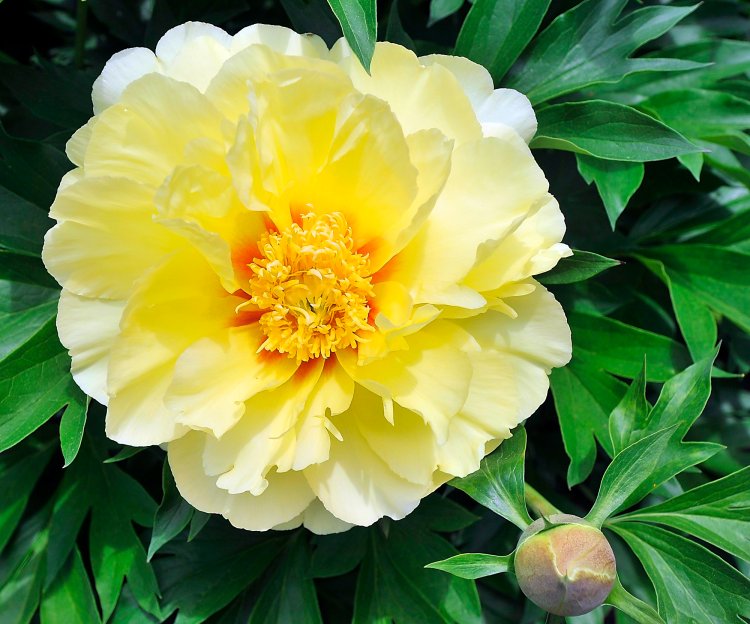When people ask me what plants I would recommend for a particular site, the answer more than half the time will be peonies.
Peonies have a lot to recommend them. They have large, striking and long-lasting flowers in a wide array of colors, attractive foliage even when they aren’t in bloom and – in some varieties – attractive seed pods that last until the frosts of late fall.
Kathleen Gagan of Peony’s Envy, a New Jersey nursery, gave the lowdown on peonies in a lecture at the Maine Flower Show in Portland last March.
Part of the reason peonies fit so many spots is that there are actually four types of peonies, each with different requirements for location, planting and care. Bloom time for peonies runs about two months, from late May through most of July.
The first peony to bloom, in late May in southern Maine, is the woodland peony, which is unusual in that it grows well in the floor of a deciduous forest, getting sun in the spring before the leaves emerge on trees, and shade for the rest of the growing season. The most common woodland peonies have large, white blossoms, which make excellent cut flowers. And they are among the easiest peonies to grow. “They are considered invasive in some places,” Gagan said.
In the fall, the woodland peony gets dramatic indigo or red seed pods that add to their attractiveness, and those seeds will produce new peonies.
Tree peonies are the second to blossom. Their blossoms can be huge, and are especially striking because the plants themselves can grow quite tall. Name aside, tree peonies aren’t trees. Rather, they are slow-growing woody shrubs that must be left standing at the end of the season. Given good conditions and enough time – they produce at most only six inches of new growth per year – tree peonies can get to be seven feet tall, Gagan said. In the fall, the foliage turns bronze or purple.
Tree peonies are more tender than the other types of peonies, and will sustain some damage after harsh winters in Zone 4, but should eventually recover, Gagan said. The tree peonies take a long time to get established and early flowers will be small. But if left alone, they will be worth it, she promised, and the plants will spread if the branches are left to root in any places where they touch the ground.
Herbaceous peonies bloom next; these are the ones that most people think of as peonies. They send up attractive red foliage early in the season, followed by buds, and will produce blossoms that can range, depending on the variety, from delicate single flowers to huge globes of bright petals.
I recommend herbaceous peonies to people whose shrubs near their driveways are ruined by snowplows and to gardeners addicted to lush color. Peony roots are usually too deep to be injured by plow blades but peony clumps will grow larger each year and make a nice border to your driveway.
Intersectional peonies are the last to blossom. They also were the last to come to market, created in 1948 when Toichi Itoh crossed a herbaceous peony with a tree peony. In doing so, he created plants that bloom over a longer time with more blossoms per plant.
Gagan stressed that peonies – all four types – require patience. Typically, they look bad for the first three years and many won’t look really good until they have been growing for seven years, she said.
Planting is when people create most of their problems with peonies, she said. Traditionally, gardeners plant a root that has been divided from a large plant. Peonies want a loose soil, with lots of organic matter, generally slightly alkaline.
For herbaceous and intersectional peonies, Gagan recommends digging a hole about a foot deep, and then refilling the hole so that the top of the root is about an inch below the soil line. Be sure to remove large rocks and add compost and/or dehydrated cow manure. One of the reasons peonies don’t bloom, Gagan emphasized, is that they are planted too deeply. These divisions can be planted either in the fall or the spring, she said, but plant them when you get them. You also can buy potted peonies in nurseries, which should also be planted soon after purchasing.
Tree peonies, on the other hand, want to be planted deeply. If the tree peony is grafted, the graft should be four to six inches below the ground.
Ideally, Gagan said, people should plant peonies once and leave them in that spot for a century or more. The plants are happiest that way. But people do like to divide them to get more for themselves and to give away or sell. Divide them in the fall, after the plant is dormant. Start a foot outside the farthest-out stem and a foot deep when you are digging up the plant, and then wash the soil from the roots – so you can see what you are doing. The dug-out plant will have a crown, with eyes on that crown. Cut the crown so that each piece has three to five buds on the top of the crown and one strong, tuberous root.
When you replant the divided peonies, place them at least three feet apart. And know that it will take three to seven years before they look their best again.
TOM ATWELL is a freelance writer gardening in Cape Elizabeth. He can be contacted at: tomatwell@me.com
Send questions/comments to the editors.


